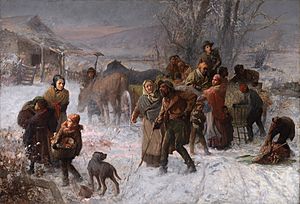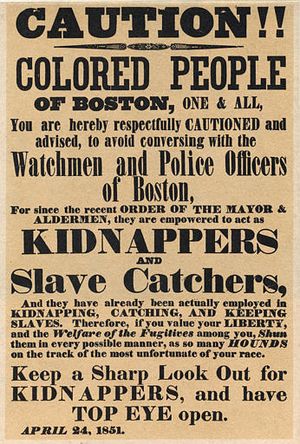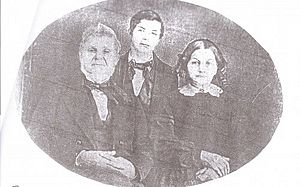Merlin Mead facts for kids
Merlin Mead (born August 18, 1794 – died December 23, 1874) was a very important person in the Underground Railroad. He helped enslaved people escape to freedom in Canada. He was one of many brave people from a small town called Cadiz, in Franklinville, New York, who offered shelter and help. Merlin Mead had many jobs during his life. He was a farmer, a school teacher, a town clerk, a postmaster, and even a judge (justice of the peace). He also ran a public house, but he stopped selling alcohol after attending a meeting about not drinking. He was a respected leader and elder in the First Presbyterian Church in Franklinville.
Contents
Early Life and Family
Merlin Mead was born on August 18, 1794, in South Salem, New York, which is in Westchester County, New York. His parents were Lois and Clark Mead. His father's family came to the American colonies from England before the American Revolutionary War. They first settled in Greenwich, Connecticut.
When he was young, Merlin worked on his family's farm during the summer. In the winter, he taught at the local school. On November 14, 1820, he married Polly Clark. She was the daughter of Eli Clark from Waterbury, Connecticut. Merlin and Polly had eight children together. They were born between the years 1821 and 1842.
Merlin Mead's Work and Community Role
Merlin and Polly Mead, along with a person named Mr. McKean, ran a night school in New York City. The Meads are also known for starting a school for boys who didn't have many advantages in the city. Two of their students became famous inventors of printing presses: Richard March Hoe and Robert Hoe. The Meads were active members of the Cedar Street Presbyterian Church while living in the city.
Polly's health wasn't good in the city, so they moved to Franklinville, New York, in the fall of 1830. There, they opened a public house on Elm Street with Merlin's sister Laura and her husband Seth Ely. This place later became known as the Ten Broeck House. In 1833, Merlin and Polly went to a meeting of the American Temperance Society in Arcade, New York. After this meeting, they decided to stop selling alcoholic drinks forever.
Merlin also taught at the old red schoolhouse for two winters. He served as the Town Clerk and a Justice of the Peace in Franklinville. When a post office opened in Cadiz, Merlin was chosen to be the postmaster. He also continued to work as a farmer.
The Meads were very involved in the town's First Presbyterian Church. Merlin became an elder in the church. He would even fill in for the minister when needed. He was also the Clerk of Sessions and the Superintendent, showing his strong leadership in the church.
Helping People on the Underground Railroad

Merlin Mead became very active in the fight against slavery. Starting in February 1834, he was the secretary of the American Anti-Slavery Society in Franklinville.
In 1841, the Meads moved to Cadiz. Here, Merlin was known for being an abolitionist, someone who wanted to end slavery. Because of his beliefs, he sometimes faced difficulties. They first lived in the Howe-Prescott House, which is now a museum. Later, they built a bigger house, but it was sadly destroyed in a fire. Merlin's house became a secret "station" on the Underground Railroad. This network helped enslaved people escape to freedom before and during the American Civil War.

Merlin Mead worked with other brave people in the area. These included John Burlingame, who ran the Stagecoach Inn, Alfred Rice, and Isaac Searle. They worked in secret to help people seeking freedom. They knew they could be sent to jail or fined heavily for their actions. Laws like the Fugitive Slave Act of 1793 and the Fugitive Slave Act of 1850 made it illegal to help escaped slaves.
The people involved in the Underground Railroad used secret code words, like terms from real railroads.
- Lines were the secret routes that led north to Canada.
- Conductors were the people who guided and transported freedom seekers.
- Passengers or freight were the enslaved people who were escaping.
- Stations were the safe houses or properties where people could hide.
- Stationmasters were the people like Merlin Mead who hid and helped freedom seekers on their property.
- Stockholders were people who gave money for clothes, food, and other supplies.
Merlin Mead's house was on two important routes through Cattaraugus County, New York. Freedom seekers often traveled from Olean, New York, to Mead's House in Cadiz. One path involved riding on canal boats or rafts up the Ischua Creek to Buck Pond. Another path went from Olean through Maplehurst and the Hatch Place near Hinsdale, New York, before reaching the Mead's House in Cadiz. There were other safe stops in the Cadiz area, like the Stagecoach Inn and Isaac Searle's farm.
Alfred Rice helped transport passengers from Franklinville to the next safe stop in East Aurora, New York. Sometimes, the travelers would hide under straw to stay safe during their journey. Some travelers also went to Arcade before East Aurora, on their way to Buffalo, New York.
A special historical marker was placed near Ischua Creek by the Pomeroy Foundation. It shows where travelers left their rafts in Cadiz. From there, they could go to Merlin Mead's house, through a tunnel to the Stagecoach Inn, to John Burlingame's house, or to Isaac Searl's farm. This marker recognizes the efforts made in Cattaraugus County to help escaped slaves reach Canada from the 1830s through the Civil War. Another historical marker in Cadiz also honors the citizens who helped with the Underground Railroad. It mentions that Cadiz was a center for the Underground Railroad. Escaping slaves were brought up Ischua Creek by raft and hidden in homes and the Stagecoach Inn. It specifically names the Mead, Burlingame, and Searle families as being involved. It also notes that the Howe Prescott Pioneer House, where Merlin Mead lived in 1841, is now a museum.
Helping Soldiers with Packages
Merlin Mead also helped create a system for sending packages. He wrote to his Congressman when he heard that a neighbor's son, who was a soldier, couldn't receive boots he needed from home. Because of Mead's letter, his Congressman introduced a bill to allow packages to be sent to soldiers. This bill passed, meaning all soldiers could receive packages from home. This program eventually led to the modern parcel post system that we use today.
Later Life and Passing
Merlin Mead passed away on December 23, 1874, at his home in Cadiz. His wife, Polly, died later on May 19, 1882. They were both buried at the Mount Prospect Cemetery.
|


